河海大学研究生英语课文及翻译(重点单词突出显示,特殊单词有注释)Unit 6 How to Read Body Language
- 格式:docx
- 大小:26.32 KB
- 文档页数:4
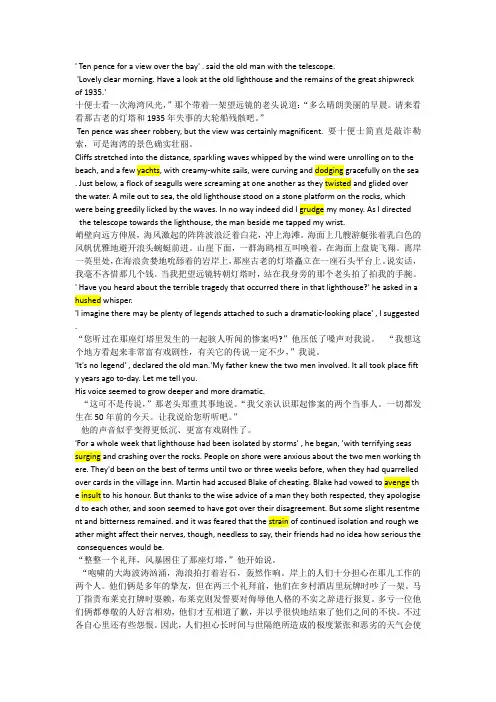
' Ten pence for a view over the bay' . said the old man with the telescope.'Lovely clear morning. Have a look at the old lighthouse and the remains of the great shipwreck o f 1935.'十便士看一次海湾风光,”那个带着一架望远镜的老头说道:“多么晴朗美丽的早晨。
请来看看那古老的灯塔和1935年失事的大轮船残骸吧。
”Ten pence was sheer robbery, but the view was certainly magnificent. 要十便士简直是敲诈勒索,可是海湾的景色确实壮丽。
Cliffs stretched into the distance, sparkling waves whipped by the wind were unrolling on to the b each, and a few yachts, with creamy-white sails, were curving and dodging gracefully on the sea . Just below, a flock of seagulls were screaming at one another as they twisted and glided over the water. A mile out to sea, the old lighthouse stood on a stone platform on the rocks, which were b eing greedily licked by the waves. In no way indeed did I grudge my money. As I directed the teles cope towards the lighthouse, the man beside me tapped my wrist.峭壁向远方伸展,海风激起的阵阵波浪泛着白花,冲上海滩。
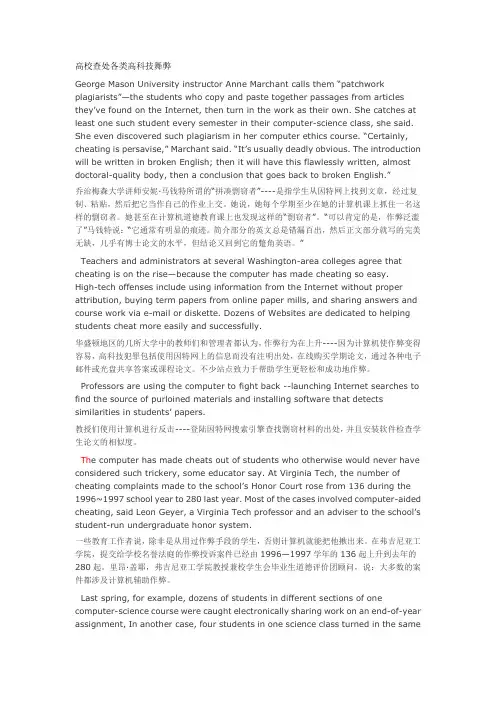
高校查处各类高科技舞弊George Mason University instructor Anne Marchant calls them “patchwork plagiarists”—the students who copy and paste together passages from articles they’ve found on the Internet, then turn in the work as their own. She catches at least one such student every semester in their computer-science class, she said. She even discovered such plagiarism in her computer ethics course. “Certainly, cheating is persavise,” Marchant said. “It’s usually deadly obvious. The introduction will be written in broken English; then it will have this flawlessly written, almost doctoral-quality body, then a conclusion that goes back to broken English.”乔治梅森大学讲师安妮·马钱特所谓的“拼凑剽窃者”----是指学生从因特网上找到文章,经过复制、粘贴,然后把它当作自己的作业上交。
她说,她每个学期至少在她的计算机课上抓住一名这样的剽窃者。
她甚至在计算机道德教育课上也发现这样的“剽窃者”。
“可以肯定的是,作弊泛滥了”马钱特说:“它通常有明显的痕迹。
简介部分的英文总是错漏百出,然后正文部分就写的完美无缺,几乎有博士论文的水平,但结论又回到它的蹩角英语。
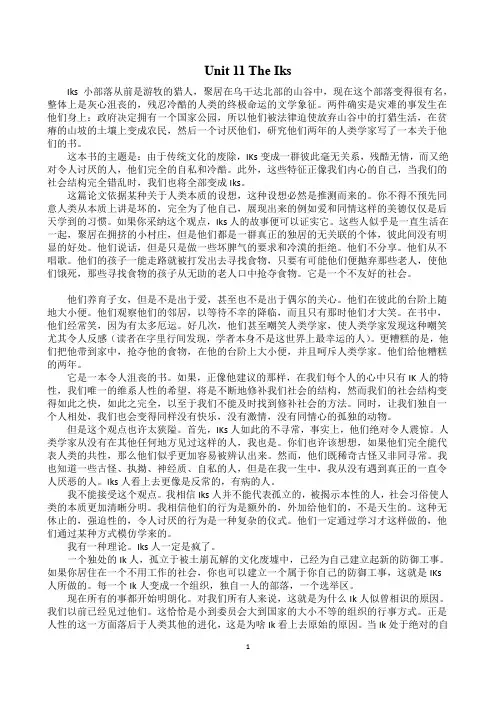
Unit 11 The IksIks 小部落从前是游牧的猎人,聚居在乌干达北部的山谷中,现在这个部落变得很有名,整体上是灰心沮丧的,残忍冷酷的人类的终极命运的文学象征。
两件确实是灾难的事发生在他们身上:政府决定拥有一个国家公园,所以他们被法律迫使放弃山谷中的打猎生活,在贫瘠的山坡的土壤上变成农民,然后一个讨厌他们,研究他们两年的人类学家写了一本关于他们的书。
这本书的主题是:由于传统文化的废除,IKs变成一群彼此毫无关系,残酷无情,而又绝对令人讨厌的人,他们完全的自私和冷酷。
此外,这些特征正像我们内心的自己,当我们的社会结构完全错乱时,我们也将全部变成Iks。
这篇论文依据某种关于人类本质的设想,这种设想必然是推测而来的。
你不得不预先同意人类从本质上讲是坏的,完全为了他自己,展现出来的例如爱和同情这样的美德仅仅是后天学到的习惯。
如果你采纳这个观点,Iks人的故事便可以证实它。
这些人似乎是一直生活在一起,聚居在拥挤的小村庄,但是他们都是一群真正的独居的无关联的个体,彼此间没有明显的好处。
他们说话,但是只是做一些坏脾气的要求和冷漠的拒绝。
他们不分享。
他们从不唱歌。
他们的孩子一能走路就被打发出去寻找食物,只要有可能他们便抛弃那些老人,使他们饿死,那些寻找食物的孩子从无助的老人口中抢夺食物。
它是一个不友好的社会。
他们养育子女,但是不是出于爱,甚至也不是出于偶尔的关心。
他们在彼此的台阶上随地大小便。
他们观察他们的邻居,以等待不幸的降临,而且只有那时他们才大笑。
在书中,他们经常笑,因为有太多厄运。
好几次,他们甚至嘲笑人类学家,使人类学家发现这种嘲笑尤其令人反感(读者在字里行间发现,学者本身不是这世界上最幸运的人)。
更糟糕的是,他们把他带到家中,抢夺他的食物,在他的台阶上大小便,并且呵斥人类学家。
他们给他糟糕的两年。
它是一本令人沮丧的书。
如果,正像他建议的那样,在我们每个人的心中只有IK人的特性,我们唯一的维系人性的希望,将是不断地修补我们社会的结构,然而我们的社会结构变得如此之快,如此之完全,以至于我们不能及时找到修补社会的方法。
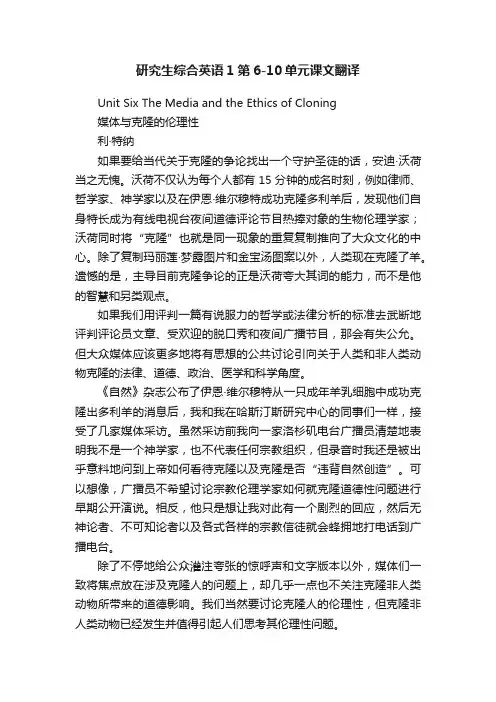
研究生综合英语1第6-10单元课文翻译Unit Six The Media and the Ethics of Cloning媒体与克隆的伦理性利·特纳如果要给当代关于克隆的争论找出一个守护圣徒的话,安迪·沃荷当之无愧。
沃荷不仅认为每个人都有15分钟的成名时刻,例如律师、哲学家、神学家以及在伊恩·维尔穆特成功克隆多利羊后,发现他们自身特长成为有线电视台夜间道德评论节目热捧对象的生物伦理学家;沃荷同时将“克隆”也就是同一现象的重复复制推向了大众文化的中心。
除了复制玛丽莲·梦露图片和金宝汤图案以外,人类现在克隆了羊。
遗憾的是,主导目前克隆争论的正是沃荷夸大其词的能力,而不是他的智慧和另类观点。
如果我们用评判一篇有说服力的哲学或法律分析的标准去武断地评判评论员文章、受欢迎的脱口秀和夜间广播节目,那会有失公允。
但大众媒体应该更多地将有思想的公共讨论引向关于人类和非人类动物克隆的法律、道德、政治、医学和科学角度。
《自然》杂志公布了伊恩·维尔穆特从一只成年羊乳细胞中成功克隆出多利羊的消息后,我和我在哈斯汀斯研究中心的同事们一样,接受了几家媒体采访。
虽然采访前我向一家洛杉矶电台广播员清楚地表明我不是一个神学家,也不代表任何宗教组织,但录音时我还是被出乎意料地问到上帝如何看待克隆以及克隆是否“违背自然创造”。
可以想像,广播员不希望讨论宗教伦理学家如何就克隆道德性问题进行早期公开演说。
相反,他只是想让我对此有一个剧烈的回应,然后无神论者、不可知论者以及各式各样的宗教信徒就会蜂拥地打电话到广播电台。
除了不停地给公众灌注夸张的惊呼声和文字版本以外,媒体们一致将焦点放在涉及克隆人的问题上,却几乎一点也不关注克隆非人类动物所带来的道德影响。
我们当然要讨论克隆人的伦理性,但克隆非人类动物已经发生并值得引起人们思考其伦理性问题。
虽然我怀疑我们能否为克隆动物找到具有说服力的论证,但不应该忽视实际上进行这样的论证与仅仅假设非人类克隆总是没有问题的这两者之间的区别。

A man or woman makes direct contact with society in two ways: as a member of some familial, pr ofessional or religious group, or as a member of a crowd. Groups are capable of being as moral a nd intelligent as the individuals who form them; a crowd is chaotic, has no purpose of its own an d is capable of anything except intelligent action and realistic thinking. Assembled in a crowd, peo ple lose their powers of reasoning and their capacity for moral choice. Their suggestibility is incre ased to the point where they cease to have any judgement or will of their own. They become ver y excitable, they lose all sense of individual or collective responsibility, they are subject to sudden excesses of rage, enthusiasm and panic. In a word, a man in a crowd behaves as though he had s wallowed a large dose of some powerful intoxicant. He is a victim of what I have called' herd-pois oning'. Like alcohol, herd- poison is an active, extravagant drug. The crowd-intoxicated individual escapes from responsibility, intelligence and morality into a kind of frantic, animal mindlessness. 一个人通过以下两种方式与社会直接接触:作为某个家庭、职业或宗教组织的成员,或者仅仅是隶属于某个群体。
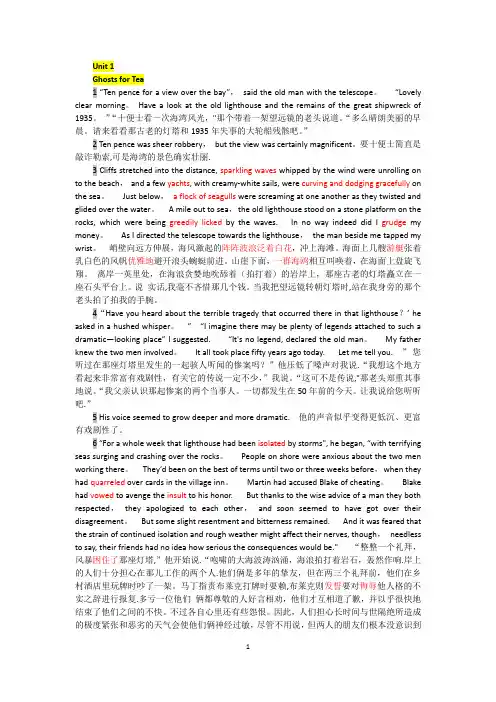
Unit 1Ghosts for Tea1 “Ten pence for a view over the bay”,said the old man with the telescope。
“Lovely clear morning。
Have a look at the old lighthouse and the remains of the great shipwreck of 1935。
”“十便士看一次海湾风光,"那个带着一架望远镜的老头说道。
“多么晴朗美丽的早晨。
请来看看那古老的灯塔和1935年失事的大轮船残骸吧。
”2 Ten pence was sheer robbery,but the view was certainly magnificent。
要十便士简直是敲诈勒索,可是海湾的景色确实壮丽.3 Cliffs stretched into the distance, sparkling waves whipped by the wind were unrolling on to the beach,and a few yachts, with creamy-white sails, were curving and dodging gracefully on the sea。
Just below,a flock of seagulls were screaming at one another as they twisted and glided over the water。
A mile out to sea,the old lighthouse stood on a stone platform on the rocks, which were being greedily licked by the waves. In no way indeed did I grudge my money。
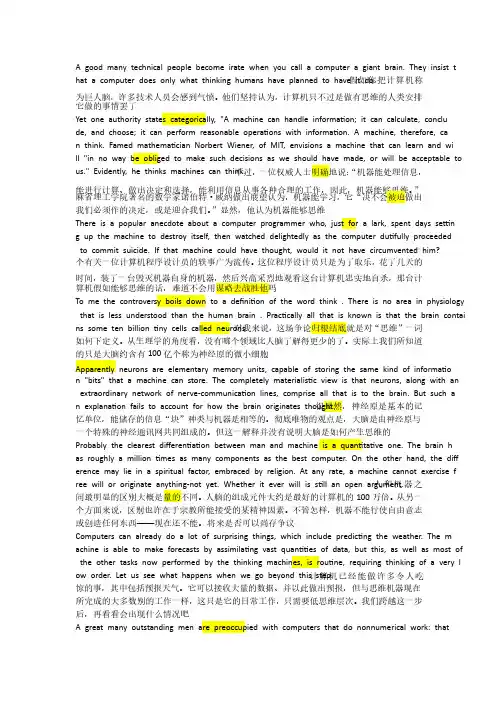
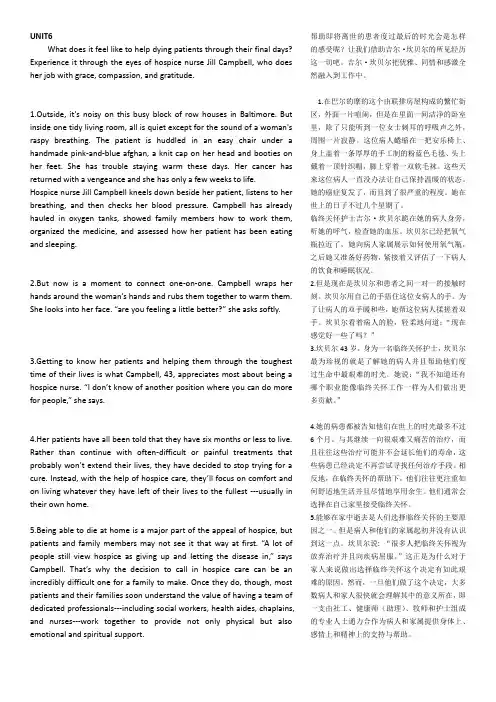
UNIT6What does it feel like to help dying patients through their final days? Experience it through the eyes of hospice nurse Jill Campbell, who does her job with grace, compassion, and gratitude.1.Outside, it's noisy on this busy block of row houses in Baltimore. But inside one tidy living room, all is quiet except for the sound of a woman's raspy breathing. The patient is huddled in an easy chair under a handmade pink-and-blue afghan, a knit cap on her head and booties on her feet. She has trouble staying warm these days. Her cancer has returned with a vengeance and she has only a few weeks to life.Hospice nurse Jill Campbell kneels down beside her patient, listens to her breathing, and then checks her blood pressure. Campbell has already hauled in oxygen tanks, showed family members how to work them, organized the medicine, and assessed how her patient has been eating and sleeping.2.But now is a moment to connect one-on-one. Campbell wraps her hands around the woman’s hands and rubs them together to warm them. She looks into her face. “are you feeling a little better?” she asks softly.3.Getting to know her patients and helping them through the toughest time of their lives is what Campbell, 43, appreciates most about being a hospice nurse. “I don’t know of another position where you can do more for people,” she says.4.Her patients have all been told that they have six months or less to live. Rather than continue with often-difficult or painful treatments that probably won’t extend their lives, they have decided to stop trying for a cure. Instead, with the help of hospice care, they’ll focus on comfort and on living whatever they have left of their lives to the fullest ---usually in their own home.5.Being able to die at home is a major part of the appeal of hospice, but patients and family members may not see it that way at first. “A lot of people still view hospice as giving up and letting the disease in,” says Campbell. That’s why the decision to call in hospice care can be an incredibly difficult one for a family to make. Once they do, though, most patients and their families soon understand the value of having a team of dedicated professionals---including social workers, health aides, chaplains, and nurses---work together to provide not only physical but also emotional and spiritual support. 帮助即将离世的患者度过最后的时光会是怎样的感受呢?让我们借助吉尔·坎贝尔的所见经历这一切吧。
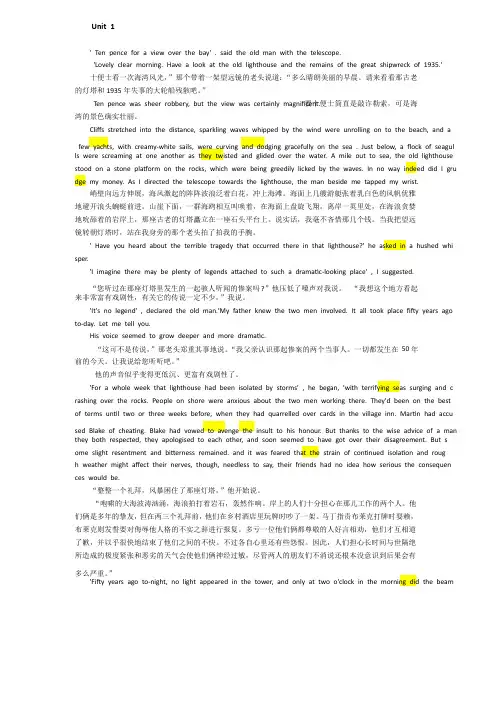

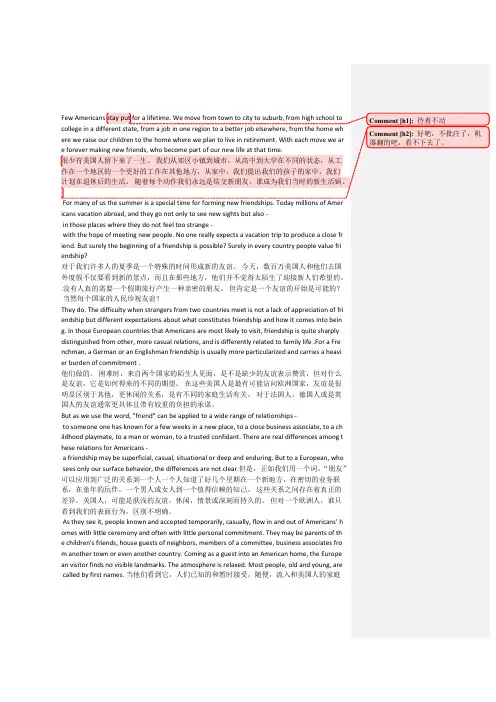
出现许多小仪式,并经常与一些个人承诺。
他们可能是孩子们的朋友的父母,邻居家里的客人,一个委员会的成员,从其他城市甚至另一个国家的商业伙伴。
作为进入美国的家里做客的到来,欧洲游客没有发现明显的地标。
气氛是轻松的。
大多数人,老的少的,被称为首先名字。
Who, then, is friend?Even simple translation from one language to another is difficult. " You see." a Frenchman explai ns, "if I were to say to you in France, 'This is my good friend, 'that person would not be as close to me as someone about whom I said only, 'This is my friend. 'Anyone about whom I have to say more is really less. " 使是简单的从一种语言翻译成另一种是困难的,“你看,”法国人解释说,“如果我说你在法国,这是我的好朋友,'这个人不会像我这样的人靠近约人我说的只是,这是我的朋友。
' 关于他我要多说任何人是真的少了。
In France, as in many other European countries, friends generally are of the same sex, and friend ship is seen as basically a relationship between men. Frenchwomen laugh at the idea that "wome n can' t be friends, "but they also admit sometimes that for women "it's a different thing. "And m any French people doubt the possibility of a friendship between a man and a woman. There is als o the kind of relationship within a group -men and women who have worked together for a long time, who may be very close, sharing gre at loyalty and warmth of feeling. They may call one another copains -a word that in English becomes "friends" but has more the feeling of "pals "or "buddies. "In Fren ch eyes this is not friendship, although two members of such a group may well be friends. 在法国,在许多欧洲国家,朋友一般都是同性,友谊是人与人之间的关系基本上是看到。
Unit 11 The IksThe small tribe of Iks, formerly nomadic hunters and gatherers in the mountain valleys of northern Uganda, have become celebrities, literary symbols for the ultimate fate of disheartened, heartless mankind at large. Two disastrously conclusive things happened to them: the government decided to have a national park, so they were compelled by law to give up hunting in the valleys and become farmers on poor hillside soil, and then they were visited for two years by an anthropologist who detested them and wrote a book about them.小部落伊克人,曾经在乌干达北部山谷里过着狩猎和采集的游牧民族生活,已变成名人,总体来说,成了最终命运沮丧的、无情的人的人文象征。
两件具有灾难性、决定性意义的事情发生在他们身上。
政府决定建一座国家公园,所以他们依法被迫放弃在山谷里的狩猎生活,而变成贫瘠的山坡地里的农民。
之后,一个憎恶他们的人类学家访问了他们两年,并写了一本关于他们的书。
The message of the book is that the Iks have transformed themselves into an irreversibly disagreeable collection of unattached, brutish creatures, totally selfish and loveless, in response to the dismantling of their traditional culture. Moreover, this is what the rest of us are like in our inner selves, and we will all turn into Iks when the structure of our society comes all unhinged.书的主旨是说,伊克人已经将自己变成了无药可救的不友善的人渣,是独立的、野兽般的生物,完全的自私无情。
老师要求背诵段落翻译,红色为老师留过的作业第一课Cliffs stretched into the distance; sparking waves whipped by the wind were unrolling on to the beach, and a few yachts, with creamy-white sails, were curving and dodging gracefully on the sea. Just below, a flock of seagulls were screaming at one another as they twisted and glided over the water. A mile out to sea, the old lighthouse stood on a stone platform on the rocks, which were being greedily licked by the waves. In no way indeed did I grudge my money. As I directed the telescope towards the lighthouse, the man beside me tapped my wrist.译文:峭壁向远方伸展,海风激起的阵阵波浪泛着白花,冲上海滩。
海面上几艘游艇张着乳白色的风帆优雅地避开浪头蜿蜓前进。
山崖下面,一群海鸥相互叫唤着,在海面上盘旋飞翔。
离岸一英里处,在海浪贪婪地吮舔着的岩岸上,那座古老的灯塔矗立在一座石头平台上。
说实话,我毫不吝惜那几个钱。
当我把望远镜转朝灯塔时,站在我身旁的那个老头拍了拍我的手腕。
第二课Groups are capable of being as moral and intelligent as the individuals who form them; a crowd is chaotic, has no purpose of its own and is capable of anything except intelligent action and realistic thinking.一个组织所表现出来的智慧和道义是与其成员的一致的,而一个群体却是无秩序的,没有特定的目的并且无法进行明智的行为和现实性的思考。
研究生英语综合教程下1-2-6单元课文原文和翻译The Hidden Side of Happiness1、Hurricanes, house fires, cancer, white-water rafting accidents, plane crashes, vicious attacks in dark alleyways. Nobody asks for any of it. But to their surprise, many people find that enduring such a harrowing ordeal ultimately changes them for the better. Their refrain might go something like this: "I wish it hadn't happened, but I'm a better person for it."飓风、房屋失火、癌症、激流漂筏失事、坠机、昏暗小巷遭歹徒袭击,没人想找上这些事儿。
但出人意料的是,很多人发现遭受这样一次痛苦的磨难最终会使他们向好的方面转变。
他们可能都会这样说:“我希望这事没发生,但因为它我变得更完美了。
”2、We love to hear the stories of people who have been transformed by their tribulations, perhaps because they testify to a bona fide psychological truth, one that sometimes gets lost amid endless reports of disaster: There is a built-in human capacity to flourish under the most difficult circumstances. Positive reactions to profoundly disturbing experiences are not limited to the toughest or the bravest. In fact, roughly half the people who struggle with adversity say that their lives have in some ways improved.我们都爱听人们经历苦难后发生转变的故事,可能是因为这些故事证实了一条真正的心理学上的真理,这条真理有时会湮没在无数关于灾难的报道中:在最困难的境况中,人所具有的一种内在的奋发向上的能力会进发出来。
心之所向,所向披靡All of us communicate with one another nonverbally, as well as with words. Most of the time we' re not aware that we're doing it . We gesture with eyebrows or a hand, meet someone else's eyes and look away, shift positions in a chair. These actions we assume are random and incidental. But researchers have discovered in recent years that there is a system to them almost as consistent a nd comprehensible as language. 我们所有人都会通过非语言的方式同其他人交流。
虽然很多时候我们并没有觉察到这一点。
我们通过手势和眉毛的变化来做敬礼的姿势,与其他人目光相遇再移开,在椅子上变换位置。
这些行为在我们看来都是随机无意的。
但研究者近年来发现这些肢体动作与语言一样,是一个连续一致且可以理解的系统。
Every culture has its own body language, and children absorb its nuances along with spoken lang uage . A Frenchman talks and moves in French. The way an Englishman crosses his legs is nothing like the way a male American does it. In talking, Americans are apt to end a statement with a dro op of the head or hand, a lowering of the eyelids. They wind up a question with a lift of the hand, a tilt of the chin, or a widening of the eyes. With a future - tense verb they often gesture with a f orward movement. 每种文化都有其独特的肢体语言,法国人以法语的方式来说话和行动。
研一上英语期末复习笔记1961 年9 月23 日,毛泽东会见英国陆军元帅蒙哥马利,其中谈到了接班人的问题。
而在前一天,毛泽东和身边的工作人员就接班人的翻译问题进行了商谈。
毛泽东问英文里继承人是什么,熊向晖答是successor,并在一张纸上写了出来。
毛泽东看后说:“success 这个单词我背过,意思是成功,怎么加上or 就翻译成继承人了?”浦寿昌解释说:“在西方,成功意味着有财产,而财产则存在继承问题,需要指定继承人。
”毛泽东说:“这个名词不好,我一无土地,二无房产,银行里也没有存款,继承我什么呀?红领巾都唱,我们是共产主义接班人,还是叫接班人好,这才是无产阶级的说法。
”期末试卷题型及考试范围☆客观题(要涂卡,记得带2B 铅笔及橡皮)①听力理解(1*20=20):基本上都是听力课教材的原题(英语一、二)②词汇(0.5*20=10):全部来自《研英》Unit1-10 课后词汇题的原题(英语一)一半来自《研英》Unit1-10 原题,一半来自《学英》Unit1-4 原题(英语二)③完形填空(1*15=15):从《研英》Unit1-10 的某篇课文原文中挖空出题(英语一、二)④阅读理解(1*20=20):有两篇来自《研英》Unit1-10 课后原题,有两篇为课外(英语一、二)☆主观题(注意把握时间,客观题可能的话尽量提前预记答案,留足够的时间给主观题)①翻译(10*2=20):一段英译汉,一段汉译英,英译汉与课文有一定的相关度(英语一、二)②写作(1*15=15):一篇大作文,英语一不详,英语二确定为图表类作文(英语一、二)《研究生英语教程》Unit 1-10 词汇题释义(英语一、二)Unit 1[辨] view / scene / scenery / sightsale n. 出售[辨] thief / bandit / burglar / robberwind - wound - wound v. 缠绕visible adj. 看得见的grim adj. 不景气的with the result that 其结果是fiction n. 小说crawl v. 爬行a flock of birds 一群鸟儿stretch out 使能维持glide v. 滑翔slide v. 滑行lick / lap up 舔食isolate / separate v. 使隔离deferential / respectful adj. 恭敬的flash out at sb. 对某人勃然大怒地说creep vi. 爬行charge sb. with sth. / accuse sb. of sth. 指控a scattering of / a sprinkle of 寥寥无几的curl vi. 盘绕Unit 2appeal to 求助于stock-in-trade n. 惯用手段be capable of 能容纳下make contact with 接触in a word 总之be subject to 经受at one’s mercy 任其摆布know one’s business 胜任自己从事的工作have no use for 不喜欢without qualification 无条件地be characteristic of 为…所特有realistic / practical adj. 现实的chaotic / disordered adj. 混乱的liquidate v. 清除[辨] destroy / ruin / damagesymptom n. 征兆[辨] symbol / signal / signcharacteristic / attribute n. 特性extravagant / wasteful adj. 奢侈浪费的suspend / postpone v. 延迟fallacy / misconception n. 谬见rational / reasonable adj. 合理的Unit 3attachment n. 依恋honor one’s commitment 信守诺言endure v. 忍受draw on 利用intensify v. 加剧courteous adj. 彬彬有礼的take sth. into account 考虑be centered on 集中在be subject to 取决于fall into step with sb. 开始与某人步调一致raise / bring up 提出confidential adj. 保密的share secrets 分享秘密draw out / extract 提炼出band / group n. 团伙sentiment / emotion n. 情绪irrevocably / unchangeably adv. 不可改变地temporary / tentative adj. 暂时性的invoke / ask for 祈求similarity / resemblance n. 相似之处view / examine v. 观察Unit 4predetermine v. 预先决定cover up 掩盖acknowledgment n. 感谢rigorous adj. 严格的diffuse adj. 弥漫的;散漫芜杂的expound v. 解释highlight n. 突出之处spring from 源于instill v. 逐渐灌输acknowledge / recognize v. 承认peer / fellow n. 同伴breakdown / fail in 失败futile /useless adj. 无用的essential / fundamental adj. 基本的thorough / rigorous adj. 缜密的evade / avoid v. 逃避explicit / clearly-expressed adj. 表述清楚的diversion / distraction n. 令人分心的事物be detached from / be indifferent to 冷漠对待Unit 5afflict v. 折磨assimilatev. 同化prescribev. 规定incumbent n. 现任者exactitude n. 规规矩矩vague adj. 模糊的dismay n. 沮丧variable n. 变量by a narrow margin 悬而又悬地muddy the waters 把事情弄糟causality n. 因果关系chalk up 取得(胜利、分)scorn / contempt n. 藐视merit / value n. 价值virtually / almost adv. 几乎hazy / uncertain adj. 模糊的stark / harsh adj. 严酷的rigid / strict adj. 严格的assimilate / digest v. 消化吸收It is incumbent on sb. to do sth. 有责任做obligatory adj. 义务的switch / shift v. 转换transaction / deal n. 交易judicious / sensible adj. 明智的implement / carry out 实施Unit 6the pros and cons 赞成与反对者stretch v. 伸展soap bubble 肥皂泡minute adj. 极小的point out 指出back off 退缩be compatible with 相一致introverted adj. 内向的densely-populated adj. 人口密集的roundabout adj. 间接的incidentally / by chance 偶然地be consistent with 相一致droop / sag vi. 下垂wind up / end 结束tilted adj. 倾斜的crooked adj. 弯曲的pick up / identify / make out 识别vocal / voiced adj. 由嗓音发出的impact / effect n. 影响spell out 讲清楚potent drug 强效药avoid / dodge v. 躲避haughty / arrogant adj. 傲慢的blink v. 眨眼chatter v. 喋喋不休idle adj. 琐碎无聊的tense / nervous adj. 紧张的rage / fury n. 暴怒provocative / stimulating adj. 起激励作用的fire up 激起热情hot adj. 激动的spot / see v. 发现Unit 7enhance one’s reputation 提高名誉respiration n. 呼吸ignite vi. 燃烧cherish v. 珍爱distinguished adj. 卓越的minimize v. 作最低估计[辨] affect / influenceoriginal adj. 最初的be related to 有关recede v. 退去scrutiny / examination n. 审查severity / seriousness n. 严重性account for / explain 解释forecast / predict v. 预测verdict / decision n. 判决overcome / defeat v. 战胜dismal / melancholy adj. 忧郁的array / collection n. 陈列thrilled adj. 非常兴奋的be caught up in / be involved in 被卷入fascinating / entrancing adj. 使人入迷的cite / quote v. 引用ample / abundant adj. 充足的relieve / alleviate v. 减轻vital / important adj. 重要的heal / cure v. 治愈treatment / medical care n. 医治nursing n. 护理enlighten / inspire v. 启发negative / pessimistic adj. 消极的emotion / feeling n. 情感Unit 8anecdote n. 轶事proceed with 继续做boil down to 归结为account for 导致at any rate 无论如何assimilate v. 消化吸收preoccupied adj. 心事重重的fall into 分成in answer to 回答conceivable adj. 可想到的comment on sth. 发表看法blunder v. 因无知或粗心而犯错误commit murder 犯谋杀罪controversy / debate n. 争论comprise / constitute v. 构成originate / emerge v. 开始出现embrace / accept v. 接受component / constituent n. 构成部分outstanding / remarkable adj. 杰出的rigid adj. 严格僵化的fixed adj. 固定的category /group n. 类colleague / fellow worker 同事maze n. 迷宫network n. 网状系统bypath n. 旁道alley n. 小巷endow / provide v. 给予multiply v. 迅速增加duplicate / identical adj. 完全一样的remark / comment v. 说reliably / dependably adv. 可靠地synthetic / artificial adj. 人造的Unit 9discard v. 丢弃clever / skillful adj. 熟练的abandon v. 放弃purify v. 提纯pure iron 纯铁emit v. 放射eliminate v. 消除determine v. 决定check v. 抑制firmadj. 坚固的preserve / save v. 保存accent / stress v. 重读sniff / smell v. 闻consume v. 花费take up 占用manufacture / produce v. 制造endless / limitless adj. 无限的exhaustive / thorough adj. 详尽的worn out adj. 用坏的dispose / array v. 排列rusty adj. 生锈的oxidize v. 使生锈stack / pile v. 摞vicious / violent adj. 凶猛的cycle n. 循环sequence n. 连续fellowship n. 交情spoil / rot vi. 腐败变质stumble / trip v. 绊倒dump / unload v. 卸下deprive sb. of sth. 剥夺deny sb. sth. 拒绝给予explode / blow up 爆炸Unit 10wistful adj. 伤感的sobering adj. 令人警醒的crave for 渴望bold adj. 大胆的hero n. 英雄upbringing n. 接受的教养hijack v. 劫机galvanize v. 激励be thronged with 挤满contentious adj. 爱争论的potentially adv. 可能地hazardous / risky a dj. 冒险的call for / require 需要last / continue v. 持续trait /quality n. 特点stimulate / encourage v. 激发inherently / intrinsically adv. 本质上地likelihood n. 可能性predictability n. 可预测性trigger / set off 引起warrior / fighter n. 斗士determine / fix v. 确定urge / encourage v. 力劝varied / diversified adj. 多样化的contention / controversy n. 争论national anthem 国歌《学术综合英语》Unit 1-4 词汇题释义(英语二)Unit 1assertion n. 声明contrary to与…相反look up 查找implicit adj. 含蓄的at hand 即将发生in the course of 在…过程中adapt v. 适应sustain v. 维持unbiased adj. 无偏见的rhythm n. 节奏clutter n. 杂乱metaphor n. 暗喻impromptu / unprepared adj. 即兴的sparingly / economically adv. 节约地credible / reliable adj. 可信赖的credential n. 证书paraphrase / restate v. 改述anecdote n. 轶事hypothetical / supposed adj. 假设的testimony / evidence n. 证明bolster / support v. 支撑juxtaposition / side-by-side position 并置impassioned adj. 充满激情的trigger v. 引发poignant adj. 令人心酸的be inundated 被淹没[usu passive] spawn v. 造成disruptv. 扰乱adverselyadv. 不利地localize v. 使局部化supplement v.补充identify v. 识别Unit 2contribute v. 投稿center on 集中在plausible adj. 看似合理的entail v. 导致consensus n. 共识liability n. 累赘menace n. 威胁triple vt. 使成三倍intractable adj. 难对付的massive adj. 大量的devastating adj. 毁灭性的pose v. 造成detract from / take away from 减损inadequacy / shortage n. 短缺on a par with / the same as 与…一样staggering / astounding adj. 令人惊愕的portend / predict v. 预示believable adj. 可信的augment v. 增加emergence / appearance n. 出现aggravating / annoying adj. 令人恼怒的pin down / discover 弄明确striking adj. 显著的resurgence n. 再度猖獗by virtue of 凭借equitable adj. 公平的implication n. 可能的结果mainstay n. 最基本组成部分thread n. 主线clear-cut adj. 清晰的virtually adv. 几乎mobility n. 社会地位或阶层升降的流动性viable adj. 可行的rife adj. 猖獗的Unit 3address v. 处理border on 近乎in other words 换句话说be involved in 被卷入enforce a ceasefire 执行停火协定be applied to 被应用于regardless of 不管conviction n. 判罪infraction n. 违犯suggest v. 暗示available adj. 可得的consistent adj. 始终如一的nail v. 逮住并证明…犯法whopping / huge adj. 巨大的sporadically / occasionally adv. 偶发地prod / urge v. 敦促fatality / death n. [C] 死亡turn up / find 发现prior to / before 在…之前on a whim 心血来潮地car crash / car accident 车祸subsequent / following adj. 接下来的indulge v. 纵情heed v. 注意听从issue v. 发布venture vi. 冒险accountability n. 应负责任give rise to 引起in place 到位predict v. 预测head for 前往Unit 4sumptuous adj. 豪华奢侈的prerogative n. 特权subtlety / delicacy n. 微妙ambiguity n. 模棱两可rapport n. 默契covert adj. 隐密的misinterpretation n. 误解subservience n. 恭顺pro forma adj. [拉] 形式上的be stricken by 受侵害national priority area 国家优先发展区域be labelled (as) 称…为[usu passive] account for 占get one’s way 为所欲为make mischief 挑拨离间frame v. 陷害debase v. 降低质量underhanded adj. 偷摸的do one’s bidding 听某人的吩咐portray v. 刻画disruptiveadj. 扰乱的stereotype n. 模式化形象trauma n. 精神上的创伤momentum n.势头flawed adj. 有瑕疵的innuendo n. 暗讽commit v. 拨款retribution n. 惩罚initiate v. 发起老师要求背诵段落翻译,红色为老师留过的作业第一课Cliffs stretched into the distance; sparking waves whipped by the wind were unrolling on to the beach, and a few yachts, with creamy-white sails, were curving and dodging gracefully on the sea. Just below, a flock of seagulls were screaming at one another as they twisted and glided over the water. A mile out to sea, the old lighthouse stood on a stone platform on the rocks, which were being greedily licked by the waves. In no way indeed did I grudge my money. As I directed the telescope towards the lighthouse, the man beside me tapped my wrist.峭壁向远方伸展,海风激起的阵阵波浪泛着白花,冲上海滩。
All of us communicate with one another nonverbally, as well as with words. Most of the time we' re not aware that we're doing it . We gesture with eyebrows or a hand, meet someone else's eyes and look away, shift positions in a chair. These actions we assume are random and incidental. But researchers have discovered in recent years that there is a system to them almost as consistent a nd comprehensible as language. 我们所有人都会通过非语言的方式同其他人交流。
虽然很多时候我们并没有觉察到这一点。
我们通过手势和眉毛的变化来做敬礼的姿势,与其他人目光相遇再移开,在椅子上变换位置。
这些行为在我们看来都是随机无意的。
但研究者近年来发现这些肢体动作与语言一样,是一个连续一致且可以理解的系统。
Every culture has its own body language, and children absorb its nuances along with spoken lang uage . A Frenchman talks and moves in French. The way an Englishman crosses his legs is nothing like the way a male American does it. In talking, Americans are apt to end a statement with a dro op of the head or hand, a lowering of the eyelids. They wind up a question with a lift of the hand, a tilt of the chin, or a widening of the eyes. With a future - tense verb they often gesture with a f orward movement. 每种文化都有其独特的肢体语言,法国人以法语的方式来说话和行动。
同样是两腿交叉,英国人与美国男人表达的意义完全不同。
说话的时候,美国人喜欢低头低手,或者降低眼睑来结束一句话.他们喜欢以抬手、翘下巴或者睁大眼睛的方式来结束一个问题。
当说到表示将来时态的动词时,他们也有一个向前的动作。
There are regional idioms, too: an expert can sometimes pick out a native of Wisconsin just by th e way he uses his eyebrows during conversation. Your sex, ethnic background, social class, and pe rsonal style all influence your body language. Nevertheless, you move and gesture within the Am erican idiom. 肢体语言亦具有区域文化特色,语言学家有时甚至可以通过说话时眉毛的变化来认出威斯康辛州的土著、你的性别、背景、社会阶层以及个人风格都影响你的肢体语言。
无论如何,你的行为举止都离不开美国文化习俗的影响。
The person who is truly bilingual is also bilingual in body language. New York's famous mayor, Fio rello La Guardia, politicked in English, Italian, and Yiddish. When films of his speeches are run wit hout sound, it's not too difficult to identify from his gestures the language he was speaking. One of the reasons English - dubbed foreign films often seem flat is that the gestures don't match the language.会两种语言的人通常在肢体语言上也表现为两面性。
纽约市的著名市长,菲奥雷洛拉瓜迪亚,会用英语、意大利语以及依地语进行演讲。
当他演讲的影片以无声的形式播放时候,就很难辨别出他在用何种语言进行演讲。
英语译制片之所以都非常生硬平淡,其中一个原因就是语言和肢体动作不匹配。
Usually the wordless communication acts to qualify the words. What the nonverbal elements ex press very often, and very efficiently, is the emotional side of the message. When a person feels li ked or disliked, often it's a case of "not what he said but the way he said it." Psychologist Albert Mehrabian has devised this formula: total impact of a message = 7 percent verbal + 38 percent vo cal + 55 percent facial. The importance of the voice can be seen when you consider that even the words "I hate you" can be made to sound sexy. 通常说话越少的交流越有效。
感性的一面通常可以通过非口头表达的形式有效传递。
一个人喜欢或者厌恶,通常表现为“他不想说但必须说”。
心理学家Albert发明了一个公式:一条信息的影响力=7%的口头语言+38%的声调+55%的面部表情。
当你觉得“我恨你”都可以让一个人说得如此性感的时候,声音的重要性由此可见一斑。
Experts in kinesics - the study of communication through body movement - are not prepared to s pell out a precise vocabulary of gestures. When an American rubs his nose, it may mean he isdisagreeing with someone or rejecting something. But there are other possible interpretations, too. F or example, when a student in conversation with a professor holds the older man's eyes a little lo nger than is usual, it can be a sign of respect and affection; it can be a subtle challenge to the prof essor' s authority; or it can be something else entirely. The expert looks for patterns in the contex t, not for an isolated meaningful gesture. 体动作学的专家,即研究肢体语言交流的专家,耶很难清晰的解释一个动作的意义。
当一个美国抹鼻子的时候,这也许表面他不同意你的观点或者拒绝什么东西。
但是,这也有另外的解释。
比如说,一个学生在与一个老教授谈话时,他注视老教授的眼睛的时间会长一些,这可能表明他的尊重,也可能是对教授权威的一种的蔑视,也可能是其他的意思。
专家学者只会共性的特征,而对特别的有意义的行为则无能为力。
Kinesics is a young science - developed in the 1950s - and very much the brainchild of one man, a nthropologist Dr. Ray L. Birdwhistell. But it already offers a wide variety of small observations. (Fo r example, eyebrows have a repertoire of about 23 possible positions; men use their eyebrows m ore than women do. ) Most people find they can shut out conversation and concentrate on watch ing body language for only about 30 seconds at a time. Anyone can experiment with it, however, simply by turning on the television picture without the sound. 人体动作学是一门新兴的学科,诞生于上世纪50年代,是一个叫Ray L. Birdwhistell的人类学家。
但它已经在广泛的领域建立了微观测(例如,眉毛有大约23个可能的位置,男人比女人更喜欢使用眉毛表达感情)。
很多人发现当他们不讲话时,每次集中精力观察肢体语言的时间持续不超过30秒。